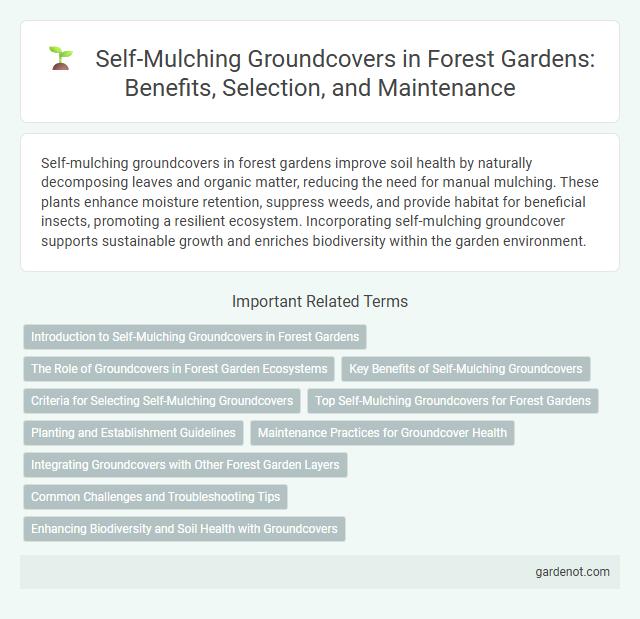Self-mulching groundcovers in forest gardens improve soil health by naturally decomposing leaves and organic matter, reducing the need for manual mulching. These plants enhance moisture retention, suppress weeds, and provide habitat for beneficial insects, promoting a resilient ecosystem. Incorporating self-mulching groundcover supports sustainable growth and enriches biodiversity within the garden environment.
Introduction to Self-Mulching Groundcovers in Forest Gardens
Self-mulching groundcovers in forest gardens improve soil health by naturally breaking down organic material and retaining moisture, reducing the need for external mulches. These plants, such as clover or creeping thyme, suppress weeds and provide habitat for beneficial insects, enhancing biodiversity within the ecosystem. Their low-growing, dense foliage protects soil from erosion while contributing nutrients, crucial for sustainable forest garden design.
The Role of Groundcovers in Forest Garden Ecosystems
Self-mulching groundcovers play a critical role in forest garden ecosystems by enhancing soil fertility through natural decomposition and moisture retention. These plants reduce erosion, suppress weed growth, and create a microhabitat that supports beneficial insects and microorganisms. Their ability to recycle nutrients and improve soil structure contributes significantly to the sustainability and resilience of diverse forest garden systems.
Key Benefits of Self-Mulching Groundcovers
Self-mulching groundcovers significantly improve soil moisture retention by naturally trapping organic matter, reducing the need for supplemental watering in forest gardens. These plants suppress weed growth through dense coverage, minimizing competition and promoting healthier tree and shrub development. Their ability to enhance soil fertility through biomass decomposition supports sustainable, low-maintenance ecosystem productivity.
Criteria for Selecting Self-Mulching Groundcovers
Effective self-mulching groundcovers in a forest garden must exhibit drought tolerance, rapid leaf drop, and high organic matter production to ensure consistent mulch formation. Preference is given to species with deep root systems that enhance soil structure and resilience, such as clover or comfrey. Selecting plants with allelopathic properties can further suppress weed growth while supporting beneficial soil microbes.
Top Self-Mulching Groundcovers for Forest Gardens
Top self-mulching groundcovers for forest gardens include species like comfrey (Symphytum officinale), which rapidly sheds leaves to improve soil organic matter and moisture retention. Other effective options are creeping thyme (Thymus serpyllum) and sweet woodruff (Galium odoratum), both providing dense coverage that suppresses weeds while enhancing nutrient cycling. These groundcovers promote healthy soil ecosystems by continuously breaking down biomass, reducing the need for manual mulching efforts in sustainable forest garden designs.
Planting and Establishment Guidelines
Self-mulching groundcovers like sweet potato (Ipomoea batatas) or creeping thyme (Thymus serpyllum) thrive when planted in well-drained soil with full sun to partial shade, ensuring rapid surface coverage that suppresses weeds and retains soil moisture. Establishment requires regular watering during the first four to six weeks and minimal disturbance to the rooting area to promote dense foliage and effective organic mulch development. Incorporating nutrient-rich compost before planting optimizes soil fertility, supporting vigorous growth and long-term soil health in forest garden ecosystems.
Maintenance Practices for Groundcover Health
Self-mulching groundcovers in forest gardens reduce soil erosion and retain moisture by naturally breaking down plant material, enhancing soil fertility and structure. Regular pruning and avoiding excessive foot traffic ensure optimal air circulation and prevent pest infestations, promoting vigorous growth. Monitoring soil moisture and supplementing with organic mulch during dry periods supports resilient groundcover health and sustained ecosystem benefits.
Integrating Groundcovers with Other Forest Garden Layers
Self-mulching groundcovers in forest gardens improve soil health by reducing erosion and retaining moisture through natural leaf litter decomposition. Integrating species like clover, sweet woodruff, and creeping thyme supports nutrient cycling and provides habitat for beneficial insects alongside shrubs and fruit trees. This layer enhances overall ecosystem diversity, promoting resilience and productivity within the multi-layered forest garden system.
Common Challenges and Troubleshooting Tips
Self-mulching groundcovers in forest gardens often face common challenges such as water retention issues, pest infestations, and inadequate nutrient cycling. To troubleshoot, improve soil drainage to prevent root rot, introduce beneficial insects to manage pests naturally, and regularly incorporate organic matter like leaf litter to enhance soil fertility. Monitoring soil moisture and adjusting irrigation accordingly helps maintain optimal groundcover health and promotes sustainable ecosystem function.
Enhancing Biodiversity and Soil Health with Groundcovers
Self-mulching groundcovers contribute significantly to forest garden ecosystems by improving soil structure and moisture retention while suppressing weeds, fostering a diverse habitat for beneficial insects and microorganisms. Plant species such as clover, creeping thyme, and sweet woodruff create a natural mulch layer that decomposes to enhance nutrient cycling and organic matter content. These groundcovers increase soil aeration and microbial activity, leading to healthier plant growth and resilient biodiversity within the garden.
Self-mulching groundcover Infographic

 gardenot.com
gardenot.com